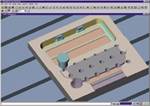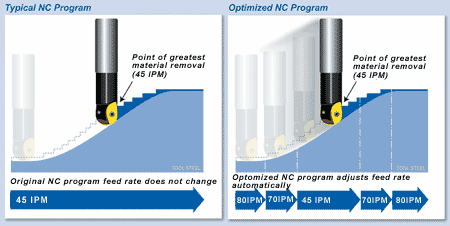Dispelling the Myths of Optimization Software
Optimization software is easier than ever to navigate, allowing moldmakers to achieve significant leadtime and cost savings while increasing efficiency.
Imagine being able to significantly reduce CNC machining time with nothing more than a few clicks of the mouse. For many years, software has been available that allows moldmakers to shave 50 percent or more off of CNC cycle time by automatically optimizing the feed rates of their NC programs. Surprisingly, many moldmakers have yet to take advantage of this technology.
Why Optimize Feedrates?
Poor feedrates contribute to excessive cycle times, bad workpiece finishes, increased cutter wear and broken tools. To be competitive in todayÕs international marketplace, NC programs must not only be fast, they must be efficient. Some NC programmers have tried to avoid the feedrate problem by applying a machining strategy that allows them to safely run the machine near its maximum feedrate for all cuts. This technique assumes that with a small-enough depth-of-cut, there is never an excessive removal rate that could break the cutter. Unfortunately, this method is not very efficient and often results in longer-than-expected run times and premature cutter wear due to the light chip load.
If software exists to make NC programs more efficient, why has it often been overlooked? Two reasons: (1) a belief that the software is difficult to use, and (2) that it is not efficient under the most hostile cutting conditions.
Ideal Cutting Conditions
Optimization software works by analyzing the NC program (G-codes or native CAM output). It then divides the motion into smaller segments to determine what conditions would benefit by increased feed rates, and where the feedrate needs to be reduced to protect the cutter. Since the software knows exactly how much material is being removed at each segment, it is able to determine the ideal feedrate. The toolpath trajectory is never altered (see Figure 1).
The key to effective optimization is accurate information about the current cutting conditions. Optimization software requires an ideal cutting condition to start withÑsomething the NC programmer traditionally needed to know before using the software. If the moldmaker did not have this information, it was difficult to configure the optimization software. CAM systems have no way to determine the volume or amount of material removed by each cut. Therefore, moldmakers were forced into the difficult task of visualizing the material removed by each cut in order to get an idea of the in-process material. From there, a best feedrate estimate was made. Because this is an extremely time-consuming and error-prone process, NC programmers were usually forced to choose only a few (or single) safe feedrate for an entire operation or tool. This has all changedÑrecent enhancements to optimization software eliminate much of that guesswork.
Configuration
To configure optimization software, the NC programmer and machinist can either allow the software to configure itself or they can rely on their own expertise. Often, a combination of the two techniques works best. Modern optimization software includes a learn mode feature, where settings are captured from an NC program that is known to run well. The captured settings are saved to a library and can be applied to other NC programs that use the same or similar tools. Users find this method to be a good starting point for making key optimization settings, such as volume removal rate, chip thickness and surface speed. Of course, if an NC programmer already knows good cutting techniques, the settings can be entered manually.
Finally, after the software has learned good cutting conditions, either from existing NC programs or from the resident expert, an interactive mode simplifies the process of setting up the next job. In this mode, there is no pre-setup. Menus prompt the user to select settings for each tool while simulating the NC program, and an optimized NC program is created in moments. The software automatically saves the settings for future use (see Figure 2).
Cutting Conditions
Another reason optimization may have been overlooked in past is the way it dealt with hostile cutting conditions on hard materials, such as conventional cuts where the cutting tooth enters tangent to the material, or narrow-width cuts where the cutter is unsupported and cuts with excessive side force. These hostile cutting conditions are typically unavoidable when cutting the complex shapes found in today's molds, but modern optimization software can identify these conditions and provides preset overrides to ensure safe and efficient feedrates under any circumstance.
There are no longer any excuses for moldmakers not to optimize their NC program. Optimizing is easier than ever and, as a result, the shop will save money, machine parts more efficiently, improve part quality, make cutters last longer and reduce machine wear.
Related Content
The Role of Social Media in Manufacturing
Charles Daniels CFO of Wepco Plastics shares insights on the role of social media in manufacturing, how to improve the “business” side of a small mold shop and continually developing culture.
Read MoreEditorial Guidelines: Editorial Advisory Board
The Editorial Advisory Board of MoldMaking Technology is made up of authorities with expertise within their respective business, industry, technology and profession. Their role is to advise on timely issues, trends, advances in the field, offer editorial thought and direction, review and comment on specific articles and generally act as a sounding board and a conscience for the publication.
Read MoreMMT Chats: Solving Schedule and Capacity Challenges With ERP
For this MMT Chat, my guests hail from Omega Tool of Menomonee Falls, Wisconsin, who share their journey with using enterprise resource planning (ERP)—and their people—to solve their schedule and capacity load monitoring challenges.
Read MoreMaking Quick and Easy Kaizen Work for Your Shop
Within each person is unlimited creative potential to improve shop operations.
Read MoreRead Next
Verifying Machining Through Simulation
NC verification technology is one of the most useful computer-aided manufacturing tools available to moldmakers, enabling engineers to simulate the machining process of an NC toolpath in order to detect and eliminate errors before machining takes place.
Read MoreHow to Use Strategic Planning Tools, Data to Manage the Human Side of Business
Q&A with Marion Wells, MMT EAB member and founder of Human Asset Management.
Read MoreHow to Use Continuing Education to Remain Competitive in Moldmaking
Continued training helps moldmakers make tooling decisions and properly use the latest cutting tool to efficiently machine high-quality molds.
Read More















.jpg;maxWidth=300;quality=90)







